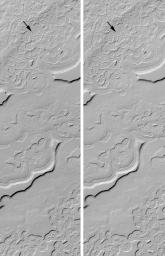
|
Changes in South Polar Carbon Dioxide Ice Cap
- Click the image above for a larger view
- Full-Res JPEG (1200 x 1868) (306.0 kB)
- Full-Res TIFF (1200 x 1868) (1.8 MB)
Caption:
Extended mission operations for the Mars Global Surveyor (MGS) Mars Orbiter Camera (MOC) has provided thousands of opportunities to image sites previously seen by the camera. Often, these are chances to see if anything on the planet has changed. The most surprising changes were documented starting in August 2001, when the south polar cap emerged from winter darkness. In 1999 MOC found that the south polar cap exhibits an array of bizarre layers, arcuate scarps, and "swiss cheese" holes and pits. How these formed was unknown. Once MOC began to re-image these areas in 2001, however, the team discovered that the polar scarps had changed. They had retreated approximately 3 meters (about 3 yards) in less than 1 Mars year (a Mars year is 687 Earth days long). In some places, small buttes completely disappeared (e.g., see arrow). In December 2001, MOC scientists reported that such rapid change could only have occurred if the south polar cap is composed mainly of frozen carbon dioxide. The image on the left, above, was taken on November 28, 1999. The picture on the right was obtained nearly 1 Mars year later on October 9, 2001. Both images are illuminated from the upper right and each covers an area 2 km (1.2 mi.) wide by 6.9 km (4.3 mi.) long.
Since the initial discovery of scarp retreat in the south polar cap in August 2001, MOC Extended Mission operations have included observation of many changes that occurred since 1999, and acquisition of new data to see how the cap changes from Spring in late 2001 through Summer in early 2002. Additional images have been obtained to help document changes when the polar cap returns to Spring in 2003.
Previous releases regarding changes in south polar cap Carbon Dioxide landforms:
- MOC Observes Changes in the South Polar Cap: Evidence for Recent Climate Change on Mars: PIA03179
- MOC View of the Martian South Polar Residual Cap: PIA03180
Background Info:
Malin Space Science Systems and the California Institute of Technology built the MOC using spare hardware from the Mars Observer mission. MSSS operates the camera from its facilities in San Diego, CA. The Jet Propulsion Laboratory's Mars Surveyor Operations Project operates the Mars Global Surveyor spacecraft with its industrial partner, Lockheed Martin Astronautics, from facilities in Pasadena, CA and Denver, CO.
Cataloging Keywords:
| Name | Value | Additional Values |
|---|---|---|
| Target | Mars | |
| System | ||
| Target Type | Planet | |
| Mission | Mars Global Surveyor (MGS) | |
| Instrument Host | Mars Global Surveyor | |
| Host Type | Orbiter | |
| Instrument | Mars Orbiter Camera (MOC) | |
| Detector | ||
| Extra Keywords | Dust, Grayscale | |
| Acquisition Date | ||
| Release Date | 2002-02-16 | |
| Date in Caption | 1999-11-28 | 2001-10-09 |
| Image Credit | NASA/JPL/MSSS | |
| Source | photojournal.jpl.nasa.gov/catalog/PIA03471 | |
| Identifier | PIA03471 | |
